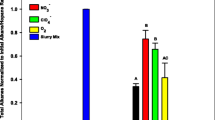Abstract
This study determined the intrinsic rates of biodegradation of Louisiana “sweet” crude oil (LSCO) in aPanicum hemitomon freshwater marsh using kinetic microcosm studies and verified the results in a large intact core study. In addition, the potential to enhance biodegradation using inorganic nutrient additions was determined. These freshwater marsh soils have high intrinsic rates of degradation (2.0%/day) for the measured alkane fraction (C11–C66) and even higher rates (6.8%/day) for the measured polycyclic aromatic hydrocarbon (PAH) fraction (naphthalene, methylated naphthalenes, phenanthrene, and methylated phenanthrenes). However, there were compound-specific effects with intrinsic rates of degradation highest for the smaller alkanes (C<15) (8.5–2.1%/day), while rates for longer chain alkanes (C>15) were much lower (0.7–1.2%/day). Results from the intact core study indicate that these rates are similar to those experiencedin situ, with the exception of the PAH fraction, whose rate constants will be substantially lower than those determined in the kinetic study. Nitrogen (ammonium) was primarily the limiting nutrient and increased degradation rate constants (2–3 fold). Few differences were seen between different classes of alkanes after fertilization. Critical nitrogen loading rates (amount needed to produce significant degradation increases) were similar for both the microcosm and core study (2.2–8.8 mg NH4 +-N/g oil), while maximum rates of degradation were observed at higher loading rates (22–44 mg NH4 +-N/g oil). While crude oil degradation can be enhanced by fertilization, the benefits need to be weighed against the presence of high intrinsic biodegradation rates in these systems.
Similar content being viewed by others
Literature cited
Bragg, J. R., R. C. Prince, E. J. Harner, and R. M. Atlas. 1994. Effectiveness of bioremediation for the Exxon Valdez spill. Nature 368:413–418.
Coates, J. D., R. T. Anderson, and D. R. Lovley. 1996. Oxidation of polycyclic aromatic hydrocarbons under sulfate reducing conditions. Applied Environmental Microbiology 62:1099–1101.
DeLaune, R. D., R. P. Gambrell, J. H. Pardue, and W. H. Patrick, Jr. 1990 Fate of petroleum hydrocarbons and toxic organics in Louisiana coastal environments. Estuaries 13:72–80.
Delaune, R. D., C. J. Smith, and M. N. Sarafyan. 1986. Nitrogen cycling in a freshwater marsh ofPanicum hemitomon on the deltaic plain of the Mississippi River. Journal of Ecology 74:249–256.
DeLaune, R. D. and C. W. Lindau. 1990. Fate of added15N labelled nitrogen in aSagittaria lancifolia L. Gulf Coast marsh. Journal of Freshwater Ecology 5:429–431.
Feijtel, T. C., R. D. DeLaune, and W. H. Patrick, Jr. 1989. Carbon, nitrogen and micronutrient dynamics in Gulf Coast marshes. p. 47–60.In R. R. Sharitz and J. W. Gibbons (eds.)Freshwater Wetlands and Wildlife.Proceedings of the International Symposium on Ecology and management of Wetlands. PUBLISHER, Charleston, SC, USA.
Hambrick, G. A. III, R. D. Delaune, and W. H. Patrick, Jr. 1980. Effect of estuarine sediment pH and oxidation-reduction potential on microbial hydrocarbon degradation. Applied Environmental Microbiology 40:365–369.
Jackson W. A. and J. H. Pardue. 1997. Seasonal variability of crude oil respiration potential in salt and fresh marshes. Journal of Environmental Quality 26:1140–1146.
Jackson, W. A., J. H. Pardue, and R. Araujo. 1996. Monitoring crude oil mineralization in salt marshes: Use of stable carbon isotope ratios. Environmental Science and Technology 30:1139–1144.
Leahy, J. G. and R. R. Colwell. 1990. Microbial degradation of hydrocarbons in the environment. Microbiological Reviews 54: 305–315.
Lee, K. and E. R. Levy. 1993. Bioremediation: waxy crude oils stranded on low energy shorelines. p. 541–547.In Proceedings 1993 International Oil Spill Conference. Washington, DC, USA.
Masscheleyn, P. H., J. H. Pardue, R. D. Delaune, and W. H. Patrick, Jr. 1992. Phosphorous release and assimilatory capacity of two lower Mississippi valley freshwater wetland soils. Water Resources Bulletin 28:763–773.
Mitsch, W. J. and J. G. Gosselink. 1993. Wetlands. 2nd edition. Van Nostrand Reinhold Company, New York, NY, USA.
Prince, R. C., E. L. Elmendorf, J. R. Lute, S. H. Chang, E. H. Copper, J. D. Senius, G. J. Dechert, G. S. Douglas, and E. L. Butler. 1994. Hopane as a conserved internal marker for estimating the biodegradation of crude oil. Environmental Science and Technology 28:142–145.
Sasser, C. E., J. G. Gosselink, and G. P. Shaffer. 1991. Distribution of nitrogen and phosphorus in a Louisiana freshwater floating marsh. Aquatic Biology 41:317–331.
Swannell, R. J. and I. M. Head. 1994. Bioremediation comes of age. Nature 368:396–397.
Venosa, A. D., M. T. Suidan, B. A. Wrenn, K. L. Strohmeier, J. R. Haines, B. L. Eberhart, D. King, and E. Holder. 1996. Bioremediation of an experimental oil spill on the shoreline of Delaware Bay. Environmental Science and Technology 30:1764–1775.
Author information
Authors and Affiliations
Rights and permissions
About this article
Cite this article
Jackson, W.A., Pardue, J.H. Potential for intrinsic and enhanced crude oil biodegradation in Louisiana’s freshwater marshes. Wetlands 19, 28–34 (1999). https://doi.org/10.1007/BF03161730
Received:
Revised:
Accepted:
Issue Date:
DOI: https://doi.org/10.1007/BF03161730




